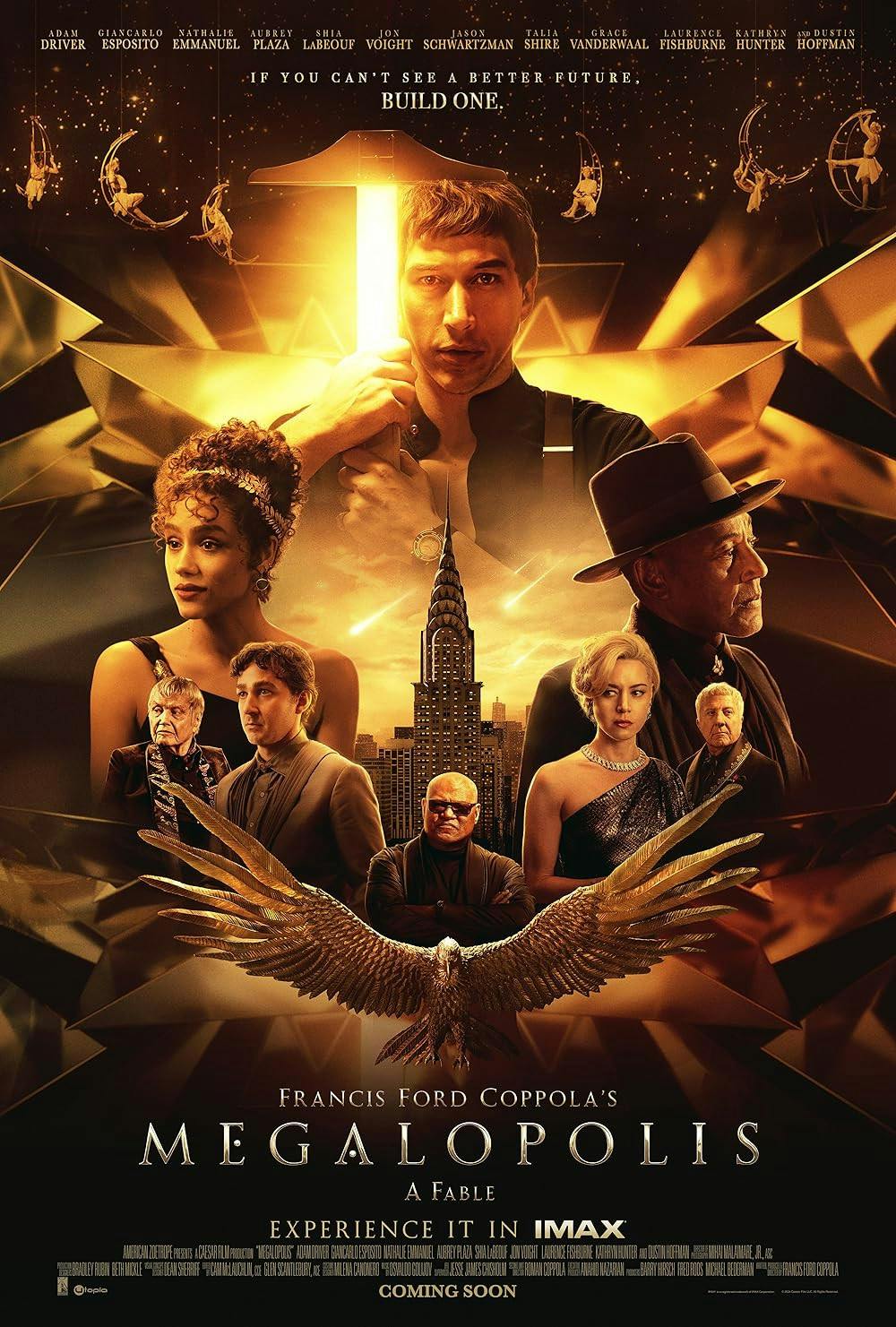Francis Ford Coppola’s 23rd total, and fourth since the turn of the century, feature film, “Megalopolis” premiered on Friday, Sept. 27 after previous screenings at Cannes and a tortured distribution process. This is about all one can say with confidence about this movie.
“Megalopolis” – a self-described “fable” – is grand, beautiful, incoherent, frustrating, navel-gazing and above all, enigmatic. It follows Cesar (Adam Driver) as a visionary artist pushing to transform the future of New Rome with the help of his miracle building material Megalon. Standing in his way is a city governed by Cicero (Giancarlo Esposito) and a group of political and financial elite that desire to keep the status quo.
The performances by standout actors such as Driver, Esposito, Aubrey Plaza (Wow Platinum), Shia LaBeouf (Clodio) and John Voight (Crassus) are hammed-up caricatures and emotionally slippery. Coppola’s audio-visual, and lighting choices are also notably out of the norm – there is heavy usage of CGI, deliberately poor ADR and a gold-hue to most scenes. The film, at one point during the screening at Cannes, breaks the fourth wall in a choice that can be kindly described as “bold”. The problem is that these off-putting choices were completely intentional, yet it’s almost impossible to understand the purpose.
This film has been circling around Coppola’s head for over 40 years. It shows through big, blunt ideas that appear sincere yet manifest in a way that only induces eye-rolls. It’s tough to witness a director with such a magnificent filmography appear so disjointed and unfocused, especially with how personal this project is for him.
Driver’s boundary pushing artist becomes an obvious stand-in for Coppola himself: New York becomes New Rome, and the city is a stand-in for both the “American Empire” and the medium of film itself. The former metaphor is completely on-the-nose and spelled out repeatedly in the film. Its heavy-handedness and laziness appear almost as window-dressing and a purposeful distraction to Coppola’s true intentions.
When Driver’s Megalon is seen as the cutting edge of filmmaking technique and not some form of Randian Rearden Steel, the film and its message begin to take shape. Jarring performances become necessary manifestations of necessary ideas, strange auxiliary decisions become boundary-pushing and the world of New Rome becomes a legitimate mirror to our own. Sadly, through stunted laughs and glances over at your fellow viewers, it’s almost impossible to engage with “Megalopolis” in this manner as you sit in the theater.
Removing any intellectualization of perceived purpose or intention – the fact of the text is: nothing makes sense. Every aspect of the film is dialed up to the nth degree, flattening emotions and leaving characters undeveloped. It’s a film of ideas, ones that it constantly verbalizes. This occurs primarily through the most frustrating character, Nathalie Emmanuel’s Julia, the love interest of Cesar (one of Coppola’s many blunt objects hits you over the head when you put their two names together: Julia-Cesar). An example of this unnecessary narration occurs in the early portion of the movie. Julia follows Cesar through the slums of the city as he arrives at an Eden-esque glowing flower stand. He proceeds to buy a bouquet and she responds to this by saying to herself something to the effect of, “Cesar buys flowers, but for who?”. Moments of frustration like this make an audience member either squirm in their seat or uncomfortably laugh. In my screening, you could feel the pensiveness in the air for the first half of the movie until the tension finally broke and the audience allowed itself to laugh at the absurdity of what was on screen.
“Megalopolis” can be viewed as an experiment in the form of filmmaking – a metatextual experiment where the film itself is Megalon. Following this metaphor, in the last act of the film, Cesar and Julia have a little girl. After an uplifting montage ending, a city-wide celebration is enclosed by an iris shot of Cesar’s daughter: an obvious call to action to change our ways for the sake of future generations. The more interesting read, however, is to view Cesar’s daughter as a one to one stand-in for Coppola’s daughter, Sophia. The final shot now becomes a metaphorical passing of the torch to a generation of future filmmakers – a generation who he has just expanded the medium for by creating such a jarring film. Again, this is generous.
“Megalopolis” is the most confounding movie I have ever seen. It loses itself in its scope, can’t seem to show rather than tell and can’t help itself to oblige whenever there is an opportunity to up the ante. The movie is so genuinely filled with hope that it makes it difficult to discuss cynically. It’s impossible to stop thinking about it. I’ve never had more fun at a movie.
Get The Chronicle straight to your inbox
Signup for our weekly newsletter. Cancel at any time.
Kadin Purath is a Trinity junior and a culture editor for Recess.

